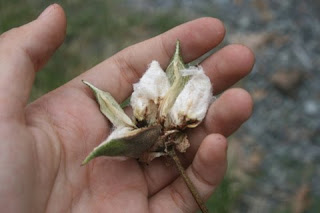
Sir John Mandeville, during the 1300s, spoke of a wool-bearing plant he named "The Vegetable Lamb", or a shrub that had tiny sheep, bent its stalks down so the breathing, hungry babies could feed on the grass, and shed the dead specimens, which were then spun into thread and made into fabric. Even more preposterous than this tale is the fact that people believed it, but I suppose Wikipedia wasn't around since the birth of man.
Some say that Mandeville was referring to cotton, some, to a large fern thing that produced white fibers that were not utilized in cloth production. Then again, most cotton-related accounts of Europeans meeting the people of the Orient contain amazement with the non-animal nature of the fiber source, as they comparede it to wool, which was also spun into yarn, but is heavier and of course, requires pasture and more care.

Now, like most people, I took the clothes off my back for granted, and had a vague idea of what cotton looked like, thanks to movies and photos of US slavery. That was before I read Cotton: The Biography of a Revolutionary Fiber by Stephen Yafa, which chronicles the rough trade routes and eventual industrialization of the crop. (It was also before my grandmother told me that her mom's fancy clothing, made with jusi and piña, had to be taken apart and re-sewn again after every washing.)
Now another step in cultivating my appreciation for the clothes I wear is growing an actual cotton plant, whose seeds I nicked from Nueva Ecija. Over the years, I've heard about it being grown spottily in the Visayas and up in Ilocos-- but the weaving industries there have also began to utilize poly-threads, which are cheap but aren't nearly as gorgeous. I've recently confirmed from someone whose father founded our cotton board (meron?) that Bulacan indeed got its name from the word bulak, which is localese for cotton. I heard that the boll weevil spared no time in wiping out a lot of plantations, probably showing no mercy, as in this song.
The history of cotton in the country is a bit sketchy, full of anecdotes and "if I remember correctly"s, and will probably be more covered in a future post.


So anyway, the cotton plant is hardy with a capital H. My seeds came up almost immediately, and appeared to have the brashness of an okra plant. They are taller than me, which is more than 5 feet tall and 8 feet. I ignored them for a bit and was out of the house and suddenly, yellow flowers came out, then things looking like raw almonds started poking out.


This will begin to become tight and pregnant with white fluff. As it turns brown, the fibers will poke out.

During the beginning I got a bit excited and began prying them apart at this stage. Seeing the white stuff made me do it, with disappointing results.

At one or two points I had worms, which rendered the cotton rejected, in the compost pile.

But most were clean, white, healthy bolls, which I processed as such (similar in scale and amusement levels as the kapok processing I wrote about before).

You can slip the white fluff out with ease, and don't count on getting its casing with it, as that will require effort. When you do pursue the boll, you will see, below the fibers, a layer of seeds. Cotton used for cloth production has much longer fibers.

The seeds are in clumps, looking like segments of a very magnified blackberry, and they are elongated, so they quite resemble blood-filled ticks. I have nothing more to say but you must separate them and pick all debris out, and you will have a nice fluffy cloud of cotton for use, so that your organic facial toner gets organic treatment as well.

A bit more reading and watching, if you are interested: medicinal qualities of cotton root bark, and a quite dorky basic video.










